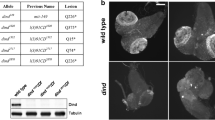Abstract
TheDrosophila homolog of the vertebrate EGF receptor (DER) gene is encoded by thetorpedo (top) locus. We examined the role oftop in the development and differentiation of the integument of the adult abdomen ofDrosophila, by analysing these processes in transheterozygotes of twotop alleles. The mutation, when compared to the wild type, affected mitosis, spreading and differentiation of adult epidermal cells derived from the various histoblast and spiracular nests. Our observations indicate that the need for wild-typetop gene product becomes critical after pupation, and the requirement continues throughout the rest of adult development for the normal morphogenesis of the abdominal integument and spiracles.
Similar content being viewed by others
References
Baker NE, Rubin GM (1992)Ellipse mutations in theDrosophila homologue of the EGF receptor affect pattern formation, cell division, and cell death in eye imaginal discs. Dev Biol 150:381–396
Bargmann CI, Hung MC, Weinberg RA (1986) Theneu oncogene encodes an epidermal growth factor receptor-related protein. Nature 319:226–230
Clifford RJ, Schupbach T (1989) Coordinately and differentially mutable activities oftorpedo, theDrosophila melanogaster homolog of the vertebrate EGF receptor gene. Genetics 123:771–787
Clifford RJ, Schupbach T (1992) Thetorpedo (DER) receptor tyrosine kinase is required at multiple times duringDrosophila embryogenesis. Development 115:853–872
Diaz-Benjumea FJ, Garcia-Bellido A (1990) Behaviour of cells mutant for an EGF receptor homologue ofDrosophila in genetic mosaics. Proc R Soc Lond B 242:36–44
Goode S, Wright D, Mahowald AP (1992) The neurogenic locusbrainiac cooperates with theDrosophila EGF receptor to establish the ovarian follicle and to determine its dorsal-ventral polarity. Development 116:177–192
Kammermeyer KL, Wadsworth SC (1987) Expression ofDrosophila epidermal growth factor homologue in mitotic cell populations. Development 100:201–210
Katzen AL, Kornberg T, Bishop JM (1991) Expression duringDrosophila development of DER, a gene related toerbB-1 andneu: correlations with mutant phenotypes. Dev Biol 145:287–301
Lev Z, Shilo BZ, Kimchie Z (1985) Developmental changes in the expression of theDrosophila melanogaster epidermal growth factor receptor gene. Dev Biol 110:499–502
Madhavan MM, Madhavan K (1980) Morphogenesis of the epidermis of adult abdomen ofDrosophila. J Embryol Exp Morphol 60:1–31
Madhavan MM, Madhavan K (1984) Do larval epidermal cells possess the blueprint for adult pattern inDrosophila? J Embryol Exp Morphol 82:1–8
Price JV, Clifford RJ, Schupbach T (1989) The maternal ventralizing locustorpedo is allelic tofaint little ball, an embryonic lethal, and encodes theDrosophila EGF receptor homolog. Cell 56:1085–1092
Schejter ED, Shilo BZ (1989) TheDrosophila EGF receptor homolog (DER) gene is allelic tofaint little ball, a locus essential for embryonic development. Cell 56:1093–1104
Snodgrass RE (1935) Principles of Insect Morphology. McGraw-Hill, New York
Ullrich A, Coussens L, Hayflick JS, Dull TJ, Gray A, Tam AW, Lee J, Yarden Y. Liberman TA, Schlessinger J, Downward J, Mayes ELU, Whittle N, Waterfield MD, Seeburg PH (1984) Human epidermal growth factor receptor cDNA sequence and aberrant expression of the amplified gene in A431 epidermoid carcinoma cells. Nature 309:418–425
Xu T, Rubin GM (1993) Analysis of genetic mosaics in developing and adultDrosophila tissues. Development 117:223–1237
Yarden Y, Ullrich A (1988) Growth factor receptor tyrosine kinases. Annu Rev Biochem 67:443–478
Zak NB, Wides RJ, Schejter ED, Raz E, Shilo BZ (1990) Localization of the DER/flb protein in embryos: Implication on thefaint little ball lethal phenotype. Development 109:865–874
Author information
Authors and Affiliations
Additional information
We dedicate this paper to the memory of the doyen of insect physiology, Sir Vincent Briar Wigglesworth, for his avalanche of seminal studies that showed the value of insects to solve key biological problems.
Rights and permissions
About this article
Cite this article
Madhavan, K., Madhavan, M.M. Defects in the adult abdominal integument ofDrosophila caused by mutations intorpedo, a DER homolog. Roux's Arch Dev Biol 204, 330–335 (1995). https://doi.org/10.1007/BF02179501
Received:
Accepted:
Issue Date:
DOI: https://doi.org/10.1007/BF02179501




